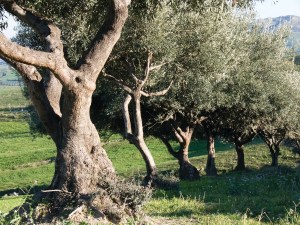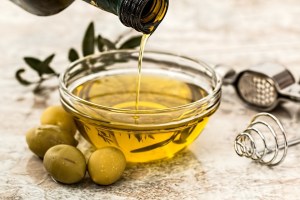本月最佳水果:橄榄

Table of contents


俗称: 奥利维拉。
学名: Olea europaea L.
See_also: 25种适合阳台和露台的植物永远盛开着资料来源: 从叙利亚和以色列的海岸,巴勒斯坦,到伊拉克北部和伊朗。
家庭: 油菜科。
历史事实/奇闻异事: 在巴勒斯坦发掘的6000多年前的定居点中发现了橄榄石。 在意大利发现了橄榄树的化石。
在北非,在撒哈拉中部山区的岩石上发现了可以追溯到6000多年前的绘画。 米诺斯文明(希腊青铜时代)在克里特岛一直生活到公元前1500年,它随着橄榄油贸易的发展,学会了种植和繁殖橄榄树。
希腊人继承了橄榄树的种植技术并继续他们的贸易,因为他们相信橄榄树给他们带来了力量和生命。
我们知道,橄榄油是具有最重要商业意义的产品之一,被装在大罐子里在船上运输。
橄榄树与宗教信仰有关,人们习惯在棕榈树周日拿着橄榄树枝去接受祝福。 现在仍有人用家养的鸟(火鸡和公鸡)来促进种子的发芽,在通过消化液后,返回的种子就更适合播种了。
橄榄的主要生产国是西班牙(最大的生产国)、意大利、希腊、土耳其、突尼斯、摩洛哥、叙利亚、阿根廷和葡萄牙。
直到最近,世界上最大的橄榄园属于Sovena公司(Azeite Andorinha和Oliveira da Serra),这是Mello集团的一个公司,拥有9700公顷的橄榄园(位于Alentejo)。
描述: 常绿树种,高度可达5-15米。树干一般不对称,不规则(扭曲),颜色偏灰。
根系非常强壮有力,延伸到深处。
授粉/受精: 花是雌雄同体或单性的,在春末(4-6月)、夏初出现。
授粉是风媒性的,所以建议栽培品种相互靠近,以便风把花粉从一株带到另一株。
生物循环: 到了第4/5年,它们已经开始生产,并能保持生产直到400-500岁,但100年后产量开始下降。
在葡萄牙(Santa Iria de Azóia)有一棵2850岁的橄榄树,是葡萄牙最古老的树。
最广泛种植的品种: 橄榄油 - "Picual", "Souri", "Cornicabra", "frantoio", "Leccino", "Koroneiki", "Sourani", "Hojiblanca", "Arbequina", "Picudo", "Manzanillo", "Mission", "Ascolano" "Farga", "Blanqueta", "Carrasqueinha", "Cobrançosa", "Cordovil de Castelo Branco", "Galega Vulgar", "Lentisqueira" ," Negruchas" , " Morisca" 。 对于润滑油- "曼萨尼亚" , " Gordal Sevilhana" , " Cordovil de Serpa" , " Macanilha Algarvia" 、"Redondal"、"Bicais"、"Calamato"、"Ascolano"、"Hojibalnca"、"Carlotas"。
野生橄榄树被称为 "Zambujeiros",可作为根茎或用于花园装饰,在海拔1500米的地方都可以看到。
可食用部分: 被称为橄榄的果实是一种绿色或黑色的核果,呈卵圆形和椭圆形。
环境条件
气候类型: 温带的地中海地区。
土壤: 几乎任何类型的土壤(包括贫瘠和干燥),只要排水良好。
然而,它最喜欢肥沃、深厚的土壤,理想的土壤是石灰质、硅质和粘土或轻微粘土。 pH值范围是6.5-8.0。
温度: 最佳状态: 15-25 ºC 最小: -9 ºC 最大: 35 ºC
发展的止境: -9 ºC
植物的死亡: -它需要的冬季温度在1,5-15,5 ºC之间。
阳光照射: 应该是高的。
水的数量: 400-600毫米/年。
海拔高度: 在高达800-1000米的海拔高度上效果最佳。
大气的湿度: 它必须是低的。


受精
受精: 用充分分解的牛羊粪便,应在秋季掩埋,用充分稀释的牛泥浆浇灌。
绿肥: 羽扇豆、苜蓿、大田豆、小田豆和藤条。
营养需求: 钾对橄榄树的施肥非常重要,钙、硼和铁等微量营养素也是如此。
栽培技术
土壤准备: 使用底土机的深度为70厘米,其他操作只为改善土壤排水。
在大多数情况下,由于对橄榄树的要求不高,所以在种植前不进行任何操作。
乘法: 通过种子(埋入1厘米深)或盾牌嫁接,在春季或秋季进行。
协会: 用绿肥,已经提到的三叶草和一些谷物。
种植日期: 秋季或早春。
指南针: 7×6,12×12或7×7。
悲哀: 修剪(每3年一次),除草。
浇水: 在夏季逐一滴下(更可取),或在旱地条件下,在树周围做一个宽槽。
昆虫学和植物病理学
虫害: 苍蝇、蚧壳虫、橄榄蛾、有、牛皮癣、木虱、象鼻虫、蓟马、蚜虫和线虫。
疾病: 细菌病(结核病)、轮枝菌病、锈病、根腐病、孔雀眼、龋齿、蚱蜢。
事故/伤害: 不太耐受水渍和潮湿。


收获和使用
何时收获: 在深秋(11-12月),只要颜色好,花梗容易松动,就用棍子打树。 要想在橄榄树绿油油的时候收割,操作在9-10月间进行。
生产 :10-20吨/公顷/年。
储存条件: 在5ºC下大约45天。
最佳消费季节: 要消费新鲜的橄榄,10-11月是最好的。
营养价值: 但一个橄榄的成分是50%的水,22%的油,19%的糖,5.8%的纤维素和1.6%的蛋白质。
用途: 橄榄油可用于众多烹饪菜肴,如鳕鱼、烤肉、沙拉等。 它还可用作燃料和化妆品。
橄榄可以作为开胃菜和与各种菜肴一起食用。
药用: 它能调节胆固醇,通便,是肝脏和胆汁的激活剂。 叶子对治疗高血压、糖尿病和动脉硬化有帮助。
See_also: 做一个豌豆荚的帐篷!专家建议: 它可以种植在贫瘠的土壤和较干燥的地区,不需要太多的照顾。
它是一种非常具有装饰性的树木,在你的花园里看起来很好。 如果你选择一个生产橄榄的品种,你可以从中获得一些好处。
你喜欢这篇文章吗?
因此,请阅读我们的杂志,订阅Jardins Youtube频道,并在Facebook、Instagram和Pinterest上关注我们。

